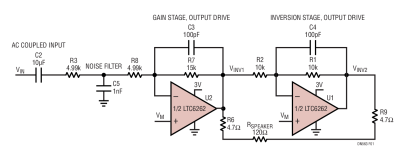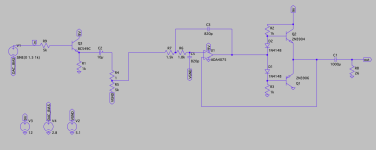The point of C4 @Mark Johnson is to avoid interaction of the pot with the reconstruction filter–so that the cutoff fq of the filter doesn't decrease with volume decrease. But actually the shift shouldn't be that much if I use a 5K pot... I could then eliminate C4 and R10 too, if I ground the pot to VGND 🙂 Then replace C2 for a bipolar or at least reverse it to block the VGND voltage higher that the DAC's–buffer bias.
Like this,
Like this,
Attachments
Use a 1K potentiometer and put it in the emitter leg of Q1 (replacing R1). Eliminates R4 and R5, and lets you brag how minimalist your design has become.
I also need C2 to decouple the DAC-bias (2.85-0.69V) from VGND (5.1V) @Mark Johnson .
It's more the output cap that makes me uncomfortable, since it cannot be oversized much in voltage rate for physical dimensions and it interacts directly with the phones. I've been researching for discrete ways to lift the phones ground to VGND voltage for a capacitor-less solution, but without much success.
It's more the output cap that makes me uncomfortable, since it cannot be oversized much in voltage rate for physical dimensions and it interacts directly with the phones. I've been researching for discrete ways to lift the phones ground to VGND voltage for a capacitor-less solution, but without much success.
I built a dual parallel opamp output buffer HPA using OPA1688’s but I think OPA1656’s would work even better. You can do a homemade etch PCB if you like. Files and data are all here:
https://www.diyaudio.com/community/...pa1688-low-thd-muscle-amp.324931/post-5494197
I have used it with 16ohm 115dB/mW IEM’s and it works great. You can skip the output coupling caps if you use a DC protection circuit (separate).



2Vpp into 47ohm load

https://www.diyaudio.com/community/...pa1688-low-thd-muscle-amp.324931/post-5494197
I have used it with 16ohm 115dB/mW IEM’s and it works great. You can skip the output coupling caps if you use a DC protection circuit (separate).
2Vpp into 47ohm load
You could use a fixed resistor. It would of course be smaller and it would actually be more reliable since trimmers can fail. But unless the devices in the left and right channels are matched, you might need different resistors in each to get the same bias current in both sides. You can determine the values on a breadboard with the actual transistors you will use before soldering. If you don't care whether the two channels have the same bias then you can just pick a reasonable value and run with it.Why do you use a trimmer instead of a 330R resistor? Would it be to find a sweet spot, how do you determine it?
And a bit extra related but taking the chance that I've got your attention: My case space is quite limited for big output caps, but I also don't want to lose any hearable bass. I found some 1000uF 6.3V Panasonic FK-V caps that are about the max. size I can afford (8x10mm). Would you have a say on that?
I'm guessing the output cap is fine, as long as it will not be seeing more than 6.3V across it. A 1000uF cap makes a 6 Hz corner frequency w/ 26 Ohm phones so you will be down less than 0.5 dB at 20 Hz. Given how little content most music has that low I suspect you wouldn't notice the difference, but your mileage may vary. This is something you can play with on the breadboard. When making compact designs I have sometimes used 680uF output caps with 32 Ohm phones and it has been fine for me.
jason
Last edited:
Thanks again Jason,
My doubts on 6.3V caps with ca.5V bias comes from a good old article:
“For the lowest possible distortion when DC blocking/signal coupling, I suggest the 16 volt pair is only used with negligible DC bias, the 35 volt pair be used to say 6 volt bias and the 63 volt pair to say 12 - 15 volts bias.”
That refers to back to back elcos. But I’ll anyways fit what I can.
Cheers!
Domingo
My doubts on 6.3V caps with ca.5V bias comes from a good old article:
“For the lowest possible distortion when DC blocking/signal coupling, I suggest the 16 volt pair is only used with negligible DC bias, the 35 volt pair be used to say 6 volt bias and the 63 volt pair to say 12 - 15 volts bias.”
That refers to back to back elcos. But I’ll anyways fit what I can.
Cheers!
Domingo
OPA1622 is designed or able to just drive headphones directly
Low noise, high bandwidth etc etc
Of course circumstances vary but distortion driving 32 ohms around .0001 %
and at 16 ohms around .0002 %
The Design shown earlier with single transistor buffer would have pretty high distortion.
not much noise rejection.
pretty simple, buffer/ filter and gain control with a opamp
then another opamp driving the load / headphones = 1622 in this case as amplifier
...all done.
If you did want to have capacitor output less design with single supply.
typical charge pump to create a dual rail from single.
TI provides a reference design for this power supply
if your Dac has current output/ differential output
there is other TI designs to use the output to drive
headphones
Low noise, high bandwidth etc etc
Of course circumstances vary but distortion driving 32 ohms around .0001 %
and at 16 ohms around .0002 %
The Design shown earlier with single transistor buffer would have pretty high distortion.
not much noise rejection.
pretty simple, buffer/ filter and gain control with a opamp
then another opamp driving the load / headphones = 1622 in this case as amplifier
...all done.
If you did want to have capacitor output less design with single supply.
typical charge pump to create a dual rail from single.
TI provides a reference design for this power supply
if your Dac has current output/ differential output
there is other TI designs to use the output to drive
headphones
Thanks for the suggestions @WhiteDragon.
I just ordered a few OPA1622 to try, I didn't know this chip and I'm impressed by the specs. The parts I ordered come with two resistors on the adapter board, would you or someone have any idea what are those resistors for? Here is a link: https://www.audiophonics.fr/en/opa/...t-p-12489.html?search_query=op&fast_search=fs
Wouldn't it be fine to use the same OPA1622 as LPF for the DAC and to drive the headphones?
The charge pump is a great reference but the LM27762 seems difficult to get and prototype. My system is single-ended.
I came up with the following experiment to "lift up" the ground with a high current PNP transistor, so headphones can be grounded on the lift and use no capacitor. The solution works and sounds actually good, but consumes quite a lot of current.

I just ordered a few OPA1622 to try, I didn't know this chip and I'm impressed by the specs. The parts I ordered come with two resistors on the adapter board, would you or someone have any idea what are those resistors for? Here is a link: https://www.audiophonics.fr/en/opa/...t-p-12489.html?search_query=op&fast_search=fs
Wouldn't it be fine to use the same OPA1622 as LPF for the DAC and to drive the headphones?
The charge pump is a great reference but the LM27762 seems difficult to get and prototype. My system is single-ended.
I came up with the following experiment to "lift up" the ground with a high current PNP transistor, so headphones can be grounded on the lift and use no capacitor. The solution works and sounds actually good, but consumes quite a lot of current.
No need for transistor.
Should be 2 channels in opamp.
Use opamp for dac input.
Circuit looks like 1622 has input right to Vcc used as Vref or Vg ( virtual ground )
needs cap.
for no output cap can also use bridged opamps.
use 2 channels of 1622 for similar circuit.

Also read TI application note
for help with stability of headphone amplifier.
and difference amplifiers for DAC
Headphones usually have big impedance peak above
20k so stability measures must be observed.
Should be 2 channels in opamp.
Use opamp for dac input.
Circuit looks like 1622 has input right to Vcc used as Vref or Vg ( virtual ground )
needs cap.
for no output cap can also use bridged opamps.
use 2 channels of 1622 for similar circuit.

Also read TI application note
for help with stability of headphone amplifier.
and difference amplifiers for DAC
Headphones usually have big impedance peak above
20k so stability measures must be observed.
- Home
- Amplifiers
- Headphone Systems
- opamp and IEMs: impedance matching and sensitivity
